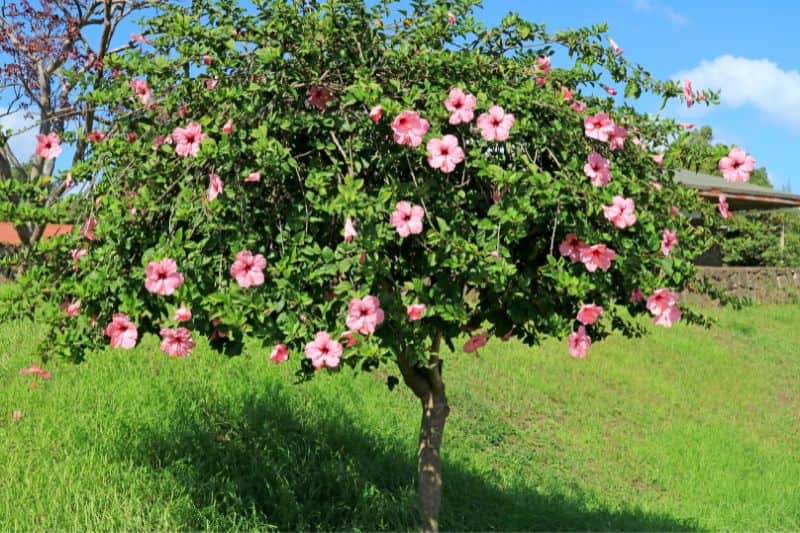Hibiscus is a beautiful bush, prized for its abundant summer flowering. Its short-lived flowers are continuously renewed from July to October, bringing an exotic feel to the garden. They come in a range of shades, from pure white to bright red, including pink and purple. This shrub will make an impact in a hedge of flowering bushes, in a border, or as a specimen. You can let its bushy habit run free or train it as a standard on a single stem to give it the form of a small tree. Discover when and how to train a Hibiscus as a tree.

A beautiful Hibiscus trained as a tree
When to prune Hibiscus as a tree?
To train an Althéa as a tree, it is important to start pruning from its first year after planting. Pruning of Hibiscus is carried out in late winter, around February–March, while bush is still in dormancy and just before sap rises.
Which Hibiscus variety to choose?
There are many Hibiscus varieties, but the good news is that they are all suitable for training as a standard. Among them are Hibiscus or Althéa of species Syriacus, prized for their hardiness down to around −20 °C. Equally well known, Althéas of species Moscheutos appreciate waterlogged soils, hence the name marsh Hibiscus.

An Althéa trained as a tree
How to train a Hibiscus as a tree?
Tools required
To train your Hibiscus as a tree (or standard) you will need :
- a young plant of Hibiscus
- a pruning shear disinfected beforehand to avoid disease transmission between plants. For large branches, you can also use a branch cutter.
- a stake and soft ties
- Optional: a pruning wound sealant
Pruning a Hibiscus into a standard:
1- Observe your Hibiscus and choose one of the main branches. It should be as straight as possible, thick and healthy.
2- Using your pruning shear, remove the other branches that start from the stump.
3- On the main branch, which is now the trunk of your Hibiscus, cut back flush the lower branches along the lower two-thirds of the trunk.
4- If you have some small branches on the upper part of the trunk, prune them to form a neat rounded head. If you do not have high branches yet, do not worry — they will appear gradually as your Althéa grows.
5- Optional but recommended: apply a pruning wound sealant to prevent pests and fungi entering through the gaps left by the cuts.
6- Next, install your stake to give good verticality to your bush. Remember to replace or loosen the stake ties as the tree grows so as not to leave marks on the trunk.
7- Repeat this operation every year, adjusting the cutting height of the lower branches according to the desired effect.
To go further :
- Discover all our varieties of Hibiscus
- To learn more, read our advice sheet on Hibiscus, Althéa: planting, growing and care.































![[plant id="hibiscus"]Train an hibiscus into a tree. shape a hibiscus into a tree](https://en.promessedefleurs.eu/blogwp/wp-content/uploads/2022/09/former-un-hibiscus-en-arbre-1.jpg)
Comments